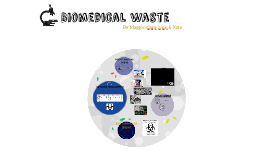Biomedical Waste Management
Transcript: Health and Environmental Risks Environmental Impact Potential Health Hazards Case Studies of Mismanagement Biomedical waste can contain infectious agents, chemicals, and sharps, posing risks to healthcare workers and the public. Exposure can lead to infections, diseases, or injuries, emphasizing the need for strict waste management protocols. Improper disposal of biomedical waste contaminates soil, water, and air, leading to ecological damage. Heavy metals and toxic chemicals can leach into the environment, posing a lasting threat to wildlife and human health. Numerous incidents highlight the consequences of biomedical waste mismanagement, such as the 2008 incident in India, where unsegregated waste led to an outbreak of infections. These cases reveal the urgent need for improved management practices. Biomedical Waste Management Introduction to Biomedical Waste The Assam Kaziranga University Biomedical Waste Biomedical waste is defined as any waste originating from medical, healthcare, or research facilities that may contain infectious, hazardous, or toxic materials. Types include sharps, infectious waste, chemical waste, and pharmaceutical waste. Sources Sources of biomedical waste include hospitals, clinics, laboratories, and research institutions. Each location generates specific waste, such as syringes, blood-stained materials, and laboratory chemicals, necessitating tailored management strategies to mitigate risks. Significance of Management Proper management of biomedical waste is critical for public health and environmental protection. Efficient disposal reduces the risk of infections, contamination of groundwater, and environmental hazards, safeguarding both human health and ecological balance. Biomedical Waste Management Process Conclusion Segregation of Waste Transportation Methods Storage and Handling Procedures Different types of biomedical waste must be segregated at the point of generation. This minimizes the risk of exposure and enhances recycling opportunities by ensuring that each waste type is disposed of properly. Treatment and Disposal Options Biomedical waste should be stored in clearly labeled, leak-proof containers until disposal. Proper storage prevents contamination and ensures safe handling by staff, reducing risk during transport. Transportation of biomedical waste must be done in sealed, durable containers that are marked with biohazard symbols. Following strict protocols during transport minimizes risk to waste handlers and the environment. Various treatment options include incineration, autoclaving, and chemical disinfection. Each method has specific regulations and effectiveness, ensuring that waste is rendered harmless before disposal. Regulatory Framework and Compliance International Standards National Guidelines International standards, such as ISO 14001, emphasize environmental management practices relevant to biomedical waste. These standards guide institutions worldwide in implementing effective waste management systems that comply with global best practices. Countries have established national guidelines that outline the responsibilities of generator, handler, and disposer of biomedical waste. These guidelines ensure compliance with health standards, minimize risks associated with waste disposal, and promote sustainable management practices. Nasim Ahmed Laskar SH23IMGGN037 BSC AIT Training and Awareness Programs Role of Healthcare Institutions Healthcare institutions play a crucial role in ensuring compliance with waste management regulations. By developing internal policies and training staff, they create a culture of safety and accountability in the handling of biomedical waste. Training programs for healthcare personnel are vital for effective biomedical waste management. Regular workshops and educational initiatives ensure that staff are aware of the latest regulations and best practices for safe waste handling. Best Practices and Safety Measures

















